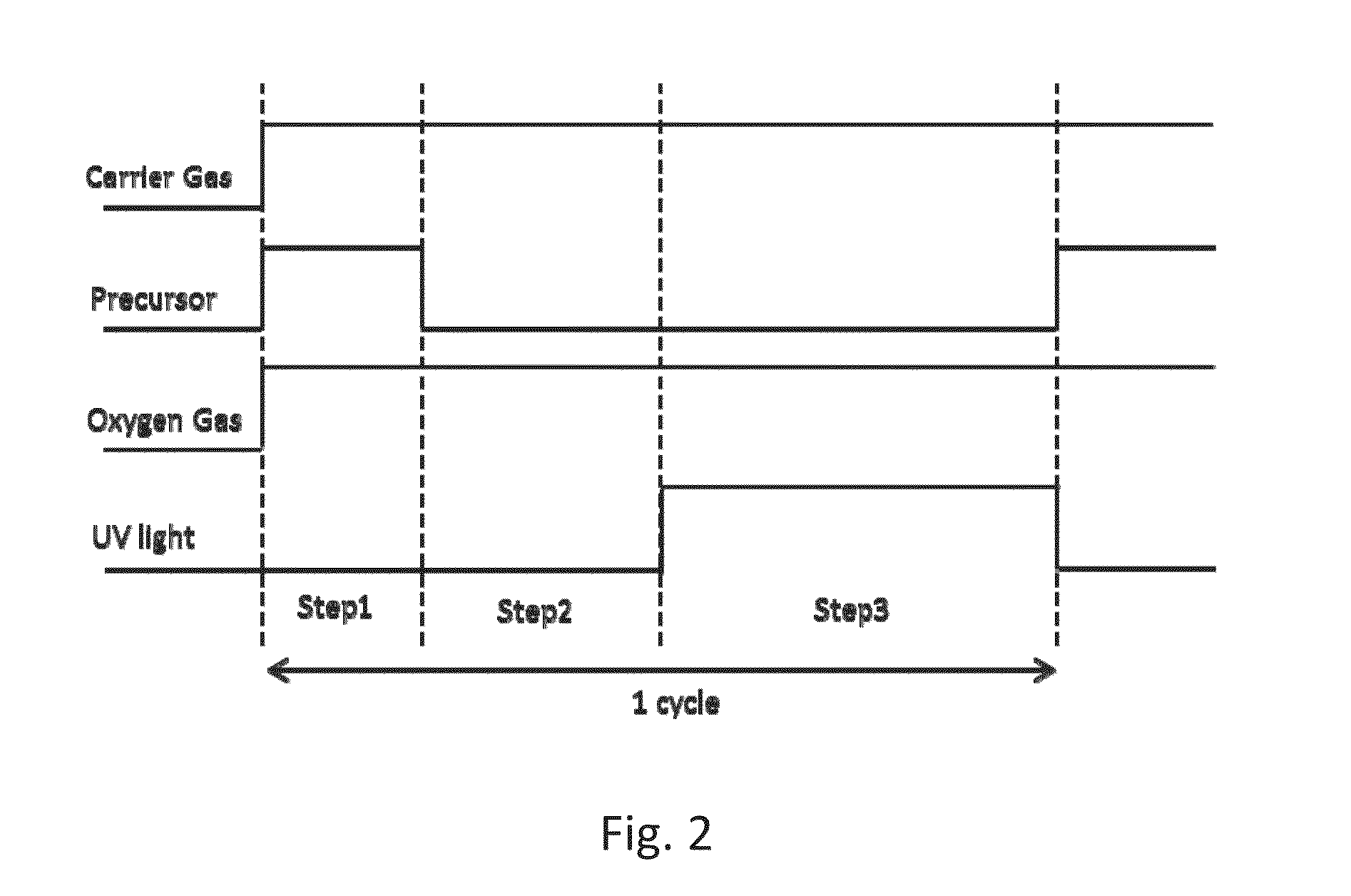Method for restoring porous surface of dielectric layer by UV light-assisted ALD
a dielectric layer and light-assisted technology, applied in the field of methods, can solve the problems of serious problems, dielectric films, and never been successful in actual industrial applications or on a mass production scale, and achieve the effect of good step coverag
- Summary
- Abstract
- Description
- Claims
- Application Information
AI Technical Summary
Benefits of technology
Problems solved by technology
Method used
Image
Examples
example 1
[0057]In this example, the apparatus shown in the schematic diagram of FIG. 1 was used to restore damaged surface of a dielectric film formed on a substrate using the process sequence illustrated in FIG. 2 under the conditions shown in Table 2.
[0058]
TABLE 2Flow rate of precursor gas* (sccm) - intermittent280Duration of supply pulse of precursor gas (seconds) - Step 12.0Type of carrier gasArFlow rate of carrier gas (sccm) - continuous2000Duration of purge (seconds) - Step 25.0Type of oxidizing gasO2Flow rate of oxidizing gas (sccm) - continuous5UV wavelength (nm)365UV power (W / cm2)120Irradiation time (seconds) - Step 310Pressure (Torr)2.0Number of cycles100*Organoaminosilane precursor (BDEAS)
[0059]Method of Experiment
[0060]A Si wafer (300 mm in diameter) on which a porous low-k film (k2.4 siloxane polymer film of 500 nm in film thickness, about 25% in porosity and about 1.2 g / cm3 in density) had been formed via plasma CVD and then exposed to oxygen plasma was transported to the heate...
example 2
[0066]A Si substrate having an isolated pattern (the distance between adjacent convex patterns was so great that the pattern could be considered to be constituted by an isolated pattern) was used and subjected to steps 1 to 4 under the same conditions as in Example 1 to form a repair film on the substrate.
[0067]FIG. 4 is a Scanning Electron Microscope (SEM) photograph of a cross-sectional view of the conformal silicon oxide film formed on the patterned silicon sample (isolated pattern). The step coverage was calculated at 124%.
example 3
[0068]A Si substrate having a dense pattern (the distance between adjacent convex patterns was so close that the pattern could be considered to be constituted by a dense pattern) was used and subjected to steps 1 to 4 under the same conditions as in Example 1 to form a repair film on the substrate.
[0069]FIG. 5 is a Scanning Electron Microscope (SEM) photograph of a cross-sectional view of the conformal silicon oxide film formed on the patterned silicon sample (dense pattern). The step coverage was calculated at 72%.
PUM
| Property | Measurement | Unit |
|---|---|---|
| temperature | aaaaa | aaaaa |
| thickness | aaaaa | aaaaa |
| dielectric constant | aaaaa | aaaaa |
Abstract
Description
Claims
Application Information
 Login to View More
Login to View More - Generate Ideas
- Intellectual Property
- Life Sciences
- Materials
- Tech Scout
- Unparalleled Data Quality
- Higher Quality Content
- 60% Fewer Hallucinations
Browse by: Latest US Patents, China's latest patents, Technical Efficacy Thesaurus, Application Domain, Technology Topic, Popular Technical Reports.
© 2025 PatSnap. All rights reserved.Legal|Privacy policy|Modern Slavery Act Transparency Statement|Sitemap|About US| Contact US: help@patsnap.com



